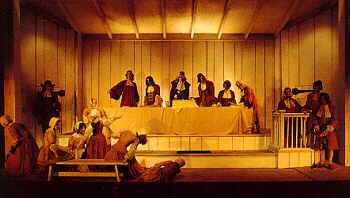
Rebecca Nurse was the daughter of William Towne, of Yarmouth, Norfolk County, England where she was baptized Feb. 21, 1621. Her sister Mary (also accused and put to death for witchcraft) married Isaac Easty. Another sister, Sarah Cloyce, was also accused of witchcraft. Nurse's husband was described as a "traymaker." The making of these articles and similar articles of domestic use was important employment in the remote countryside. He seems to have been highly respected by his neighbors, and more often than anyone else was called in to settle disputes. Nurse had four sons and four daughters.
Nurse was one of the first "unlikely" witches to be accused. At the time of her trial she was 71 years old, and had "acquired a reputation for exemplary piety that was virtually unchallenged in the community." It was written of Nurse: "This venerable lady, whose conversation and bearing were so truly saint-like, was an invalid of extremely delicate condition and appearance, the mother of a large family, embracing sons, daughters, grandchildren, and one or more great-grand children. She was a woman of piety, and simplicity of heart."
That her reputation was virtually unblemished was evidenced by the fact that several of the most active accusers were more hesitant in their accusations of Nurse, and many who had kept silent during the proceedings against others, came forward and spoke out on behalf of Nurse, despite the dangers of doing so. Thirty-nine of the most prominent members of the community signed a petition on Nurse's behalf, and several others wrote individual petitions vouching for her innocence. One of the signers of the petition, Jonathan Putnam, had originally sworn out the complaint against Nurse, but apparently had later changed his mind on the matter of her guilt. (LINK TO DOCUMENTS RELATING TO NURSE TRIAL)
Unlike many of the other accused, during the questioning of Nurse, the magistrate showed signs of doubting her guilt, because of her age, character, appearance, and professions of innocence. However, each time he would begin to waiver on the issue, someone else in the crowd would either heatedly accuse her or one of the afflicted girls would break into fits and claim Nurse was tormenting her. Upon realizing that the magistrate and the audience had sided with the afflicted girls Nurse could only reply, " I have got nobody to look to but God." She then tried to raise her hands, but the afflicted girls fell into dreadful fits at the motion.
At Nurse's trial on June 30, the jury came back with a verdict of "Not Guilty." When this was announced there was a large and hideous outcry from both the afflicted girls and the spectators. The magistrates urged reconsideration. Chief Justice Stoughton asked the jury if they had considered the implications of something Nurse had said. When Hobbs had accused Nurse, Nurse had said "What do you bring her? She is one of us." Nurse had only meant that Hobbs was a fellow prisoner. Nurse, however, was old, partially hard of hearing, and exhausted from the day in court. When Nurse was asked to explain her words "she is one of us," she did not hear the question. The jury took her silence as an indication of guilt. The jury deliberated a second time and came back with a verdict of guilty. Shocking as it seems today, it was not uncommon in the seventeenth century for a magistrate to ask the jury to reconsider its verdict. Her family immediately did what they could to rectify the mistake that had caused her to be condemned, but it was no use. Nurse was granted a reprieve by Governor Phips, however no sooner had it been issued, than the accusers began having renewed fits. The community saw these fits as conclusive proof of Nurse's guilt.
On July 3, this pious, God fearing woman was excommunicated from her church in Salem Town, without a single dissenting vote, because of her conviction of witchcraft. Nurse was sentenced to death on June 30. She was executed on July 19. Public outrage at her conviction and execution have been credited with generating the first vocal opposition to the trials. On the gallows Nurse was "a model of Christian behavior," which must have been a sharp contrast to Sarah Good, another convicted witch with whom Nurse was executed, who used the gallows as a platform from which to call down curses on those who would heckle her in her final hour. It was not until 1699 that members of the Nurse family were welcomed back to communion in the church, and it was fifteen years later before the excommunication of Nurse was revoked. In 1711, Nurse's family was compensated by the government for her wrongful death.--KS
